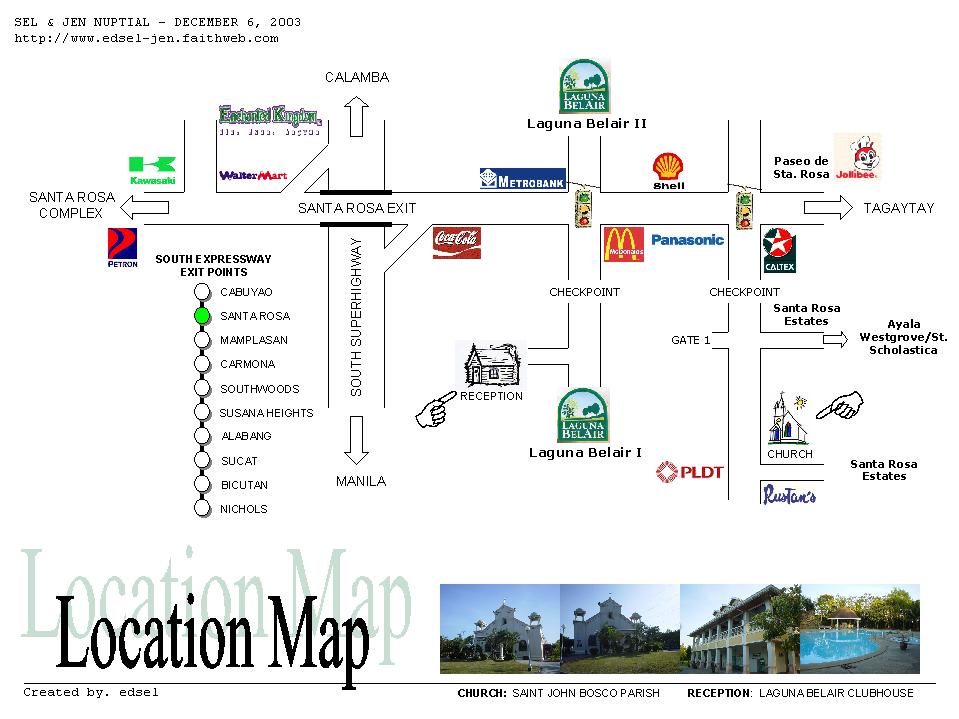Church:
St. John Bosco Parish
Laguna Technopark, Sta. Rosa, Laguna
Reception:
Laguna Belair Clubhouse
Sta. Rosa, Laguna
|
 Location Map
Location Map
|
|
HOW TO GET THERE?
From Manila By Car
1. Take the South Superhighway.
2. Exit at Santa Rosa exit.
3. Turn right going to Tagaytay.
4. Go straight until you see a stop light, caltex station & Panasonic.
5. Turn right, and then go straight ahead until you see Rustan on the left side and PLDT on the right side.
6. Turn left going to the church.
From Manila by Bus
1. Take JAM bus going to Balibago Santa Rosa.
2. Get off at a corner after the Santa Rosa exit.
3. Take a tricycle going to Saint John Bosco Parish Church.
4. You will be charge P50.00 per special ride.
|
 Saint John Bosco Parish
Saint John Bosco Parish
Laguna Technopark, Santa Rosa Laguna
|
|
Story of Saint John Bosco
John Melchior Bosco was born into a family of poor farmers on August 16, 1815 at Becchi, a hamlet near Turin, Italy. He was orphaned of his father at the tender age of two. His mother, Margaret, took on the task of bringing up her three children with tenderness and great courage. She taught them to till the soil and to see God's presence in the beauty of the sky, in the abundant harvest and in the storm which destroyed their vines.
A mysterious dream at the age of nine left an indelible stamp on his life. He saw himself amidst scruffy street kids who were fighting and using abusive language. He jumped in to stop the commotion, hitting out wildly with his fists. A majestic personage, who introduced himself as Jesus stopped him short. He promised to give John a teacher who would show him how to deal with the ragamuffins who, to John's horror, had metamorphosed into ferocious beasts.
At that instant a beautiful lady appeared, Mary, the mother of Jesus. "Not with blows", she said, "but with loving kindness!" And as she spoke the wild beasts became gentle lambs. She left him with an agenda for life. "Make yourself humble, steadfast and strong."
John saw in the dream a divine commission to work for poor and abandoned urchins. The long years that followed were directed by an amazing enthusiasm to make that dream come true, which was not without its share of humiliation and incredible hardship.
In order to pursue his studies to the priesthood, John had to leave home to join the city school. Being bigger than his classmates, he was often the object of much ridicule. Little did they know what it cost him - earning whatever he could after school, and studying by the light of a candle at night.
He was ordained a priest in 1841 and took as his counselor Don Joseph Cafasso, a teacher with a very down-to-earth spirituality. On his advice, young Bosco explored human misery through the by-lanes and market places of Turin and was deeply disturbed.
Everywhere he looked he saw young people - unemployed, sad, roving the streets, available for any activity whatsoever. His visits to the prisons disturbed him even more. He made up his mind: 'At all costs, I must stop boys, from ending up here.'
One December day in 1841, Bartholomew Garelli, a migrant from a village called Asti, entered the church to seek warmth from the biting cold. The angry servant drove the boy out. Don Bosco rebuked him and ordered him to bring 'his friend' back. Then putting a warm arm around Bartholomew, he sat him down and began to teach him how to whistle and to pray.
He invited the boy to come again, on condition he bring his friends too. Three days later he had around him nine urchins, a month later, twenty five, that grew to eighty. And by the summer of 1842 he had over 300 boys!
This large following of ragamuffins angered the neighbors. It lost him a lucrative job as the chaplain of a rich countess. It enticed the insurgents to consider using his boys to further their prospects for an independent Italy. The impeding political revolution and the possibility of the boys joining the rebels, instigated some bureaucrats to dissuade Don Bosco from gathering his boys. It incited some of his superiors to question the value of his priesthood. It even made his fellow clergymen arrange to lock him up in a mental asylum 'for his own good'.
Meanwhile the boys who frequented Don Bosco's club began to accept him as their father and guide. Some expressed their desire to become like him. And so, the Salesian Society, comprising priests and lay brothers, was born (The word 'Salesian' is from the name of the patron St. Francis de Sales - a saint much admired by Don Bosco for his conversion from an angry man to a kind and gentle bishop.)
As his work acquired recognition and spread beyond the confines of Italy. Don Bosco felt inspired to begin new initiatives in order to embrace many more young people. He founded the society of 'The Daughters of Mary Help of Christians', to extend his educational services to girls as well. 'The Union of Salesian Cooperators' was the third order he established which consisted of lay people who choose to serve the youth while still being members of their families.
In the early hours of January 31, 1888, Don Bosco breathed his last. The three societies he founded bear witness to his ardent love and concern for the young.
But undoubtedly, the greatest gift he has left posterity is his unique way of education. A method that was inspired by his one magnificent obsession: It is enough to know that you are young and abandoned for me to love you very much.
|
|